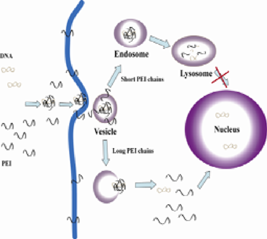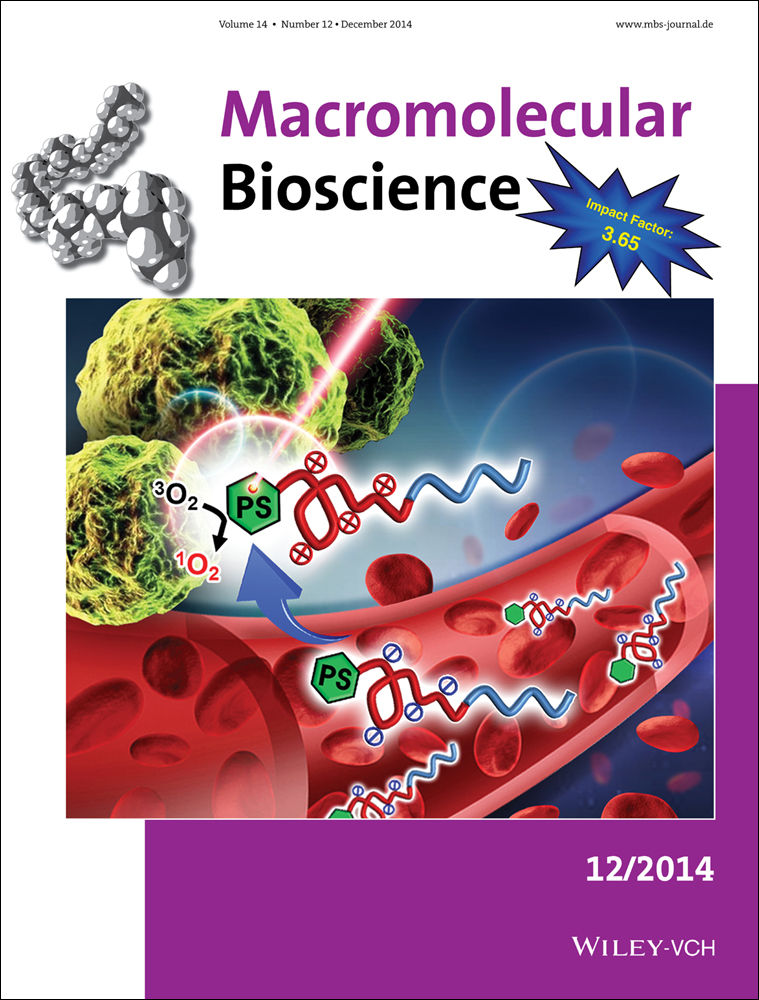Revisiting Complexation between DNA and Polyethylenimine: Does the Disulfide Linkage Play a Critical Role in Promoting Gene Delivery?
Corresponding Author
Yongzheng Ma
Department of Chemistry, The Chinese University of Hong Kong, Shatin, N. T., Hong Kong
Search for more papers by this authorBaizhu Chen
Department of Chemistry, The Chinese University of Hong Kong, Shatin, N. T., Hong Kong
Search for more papers by this authorNing He
Department of Chemistry, The Chinese University of Hong Kong, Shatin, N. T., Hong Kong
Search for more papers by this authorGaojian Chen
Department of Chemistry, The Chinese University of Hong Kong, Shatin, N. T., Hong Kong
Search for more papers by this authorLianwei Li
The Hefei National Laboratory of Physical Science at Microscale, Department of Chemical Physics, University of Science and Technology of China, Hefei, Anhui, 230026 China
Search for more papers by this authorChi Wu
Department of Chemistry, The Chinese University of Hong Kong, Shatin, N. T., Hong Kong
The Hefei National Laboratory of Physical Science at Microscale, Department of Chemical Physics, University of Science and Technology of China, Hefei, Anhui, 230026 China
Search for more papers by this authorCorresponding Author
Yongzheng Ma
Department of Chemistry, The Chinese University of Hong Kong, Shatin, N. T., Hong Kong
Search for more papers by this authorBaizhu Chen
Department of Chemistry, The Chinese University of Hong Kong, Shatin, N. T., Hong Kong
Search for more papers by this authorNing He
Department of Chemistry, The Chinese University of Hong Kong, Shatin, N. T., Hong Kong
Search for more papers by this authorGaojian Chen
Department of Chemistry, The Chinese University of Hong Kong, Shatin, N. T., Hong Kong
Search for more papers by this authorLianwei Li
The Hefei National Laboratory of Physical Science at Microscale, Department of Chemical Physics, University of Science and Technology of China, Hefei, Anhui, 230026 China
Search for more papers by this authorChi Wu
Department of Chemistry, The Chinese University of Hong Kong, Shatin, N. T., Hong Kong
The Hefei National Laboratory of Physical Science at Microscale, Department of Chemical Physics, University of Science and Technology of China, Hefei, Anhui, 230026 China
Search for more papers by this authorAbstract
Despite its cytotoxicity, polyethylenimine (PEI) is still used as a golden reference in gene transfection. Long PEI chains are more effective but also more cytotoxic. To solve this problem, an alternative strategy is to link short PEI chains into a longer PEI with disulfide bonds because they are degradable in the cell. However, how PEI promotes gene transfection is still unclear. Also, the chain length of PEI is also increased as disulfide bonds are formed. Therefore, it is important to investigate whether the increase in transfection efficiency is attributable to the disulfide linkage, chain size, or both. To distinguish between such factors, a novel method is developed here to make longer linear PEI with disulfide bonds (lPEIs-s) by linking the mercapto groups of short linear PEI (lPEIi). By comparing the physiochemical properties and the transfection efficiencies of short lPEIi, long lPEIs-s, and un-degradable long PEI, it is found that introducing disulfide bonds instead of directly using longer PEI chains has less effect on gene transfection, and it is the chain length that plays a key role in promoting gene transfection.
Supporting Information
As a service to our authors and readers, this journal provides supporting information supplied by the authors. Such materials are peer reviewed and may be re-organized for online delivery, but are not copy-edited or typeset. Technical support issues arising from supporting information (other than missing files) should be addressed to the authors.
| Filename | Description |
|---|---|
| mabi201400253-sm-0001-SuppData.docx589.2 KB | Supporting Data |
Please note: The publisher is not responsible for the content or functionality of any supporting information supplied by the authors. Any queries (other than missing content) should be directed to the corresponding author for the article.
References
- 1 D. W. Pack, A. S. Hoffman, S. Pun, P. S. Stayton, Nat. Rev. Drug Discov. 2005, 4, 581.
- 2 A. Rolland, Adv. Drug Delivery Rev. 2005, 57, 669.
- 3 S. A. Rosenberg, P. Aebersold, K. Cornetta, A. Kasid, R. A. Morgan, R. Moen, E. M. Karson, M. T. Lotze, J. C. Yang, S. L. Topalian, M. J. Merino, K. Culver, A. D. Miller, R. M. Blaese, W. F. Anderson, N. Engl. J. Med. 1990, 323, 570.
- 4 R. G. Crystal, Science 1995, 270, 404.
- 5 E. Poeschla, P. Corbeau, F. WongStaal, Proc. Natl. Acad. Sci. USA 1996, 93, 11395.
- 6 P. L. Felgner, T. R. Gadek, M. Holm, R. Roman, H. W. Chan, M. Wenz, J. P. Northrop, G. M. Ringold, M. Danielsen, Proc. Natl. Acad. Sci. USA 1987, 84, 7413.
- 7 Y. Z. Ma, S. Hou, B. Ji, Y. Yao, X. Z. Feng, Macromol. Biosci. 2010, 10, 202.
- 8 Y. Yao, D. F. Feng, Y. P. Wu, Q. J. Ye, L. Liu, X. X. Li, S. Hou, Y. L. Yang, C. Wang, L. Li, X. Z. Feng, J. Mater. Chem. 2011, 21, 4538.
- 9 H. Q. Bao, Y. Ping, Y. Z. Pan, L. Li, J. Li, L. H. Gan, Soft Matter 2012, 8, 2518.
- 10 B. Y. Shi, H. Zhang, Z. Y. Shen, J. X. Bi, S. Dai, Polym. Chem. 2013, 4, 840.
- 11 G. Wang, H. Yin, J. C. Y. Ng, L. P. Cai, J. Li, B. Z. Tang, B. Liu, Polym. Chem. 2013, 4, 5297.
- 12 S. D. Li, L. Huang, J. Controlled Release 2007, 123, 181.
- 13 M. A. Mintzer, E. E. Simanek, Chem. Rev. 2009, 109, 259.
- 14 O. Boussif, F. Lezoualch, M. A. Zanta, M. D. Mergny, D. Scherman, B. Demeneix, J. P. Behr, Proc. Natl. Acad. Sci. USA 1995, 92, 7297.
- 15 W. T. Godbey, K. K. Wu, A. G. Mikos, Proc. Natl. Acad. Sci. USA 1999, 96, 5177.
- 16 L. Wightman, R. Kircheis, V. Rossler, S. Carotta, R. Ruzicka, M. Kursa, E. Wagner, J. Gene Med. 2001, 3, 362.
- 17 D. Fischer, T. Bieber, Y. X. Li, H. P. Elsasser, T. Kissel, Pharm. Res. 1999, 16, 1273.
- 18 W. T. Godbey, M. A. Barry, P. Saggau, K. K. Wu, A. G. Mikos, J. Biomed. Mater. Res. 2000, 51, 321.
- 19 K. Kunath, A. von Harpe, D. Fischer, H. Peterson, U. Bickel, K. Voigt, T. Kissel, J. Controlled Release 2003, 89, 113.
- 20 H. Petersen, K. Kunath, T. Kissel, A. L. Martin, S. Stolnik, C. J. Roberts, M. C. Davies, J. Controlled Release 2003, 87, 286.
- 21 A. M. Funhoff, C. F. van Nostrum, G. A. Koning, N. M. E. Schuurmans-Nieuwenbroek, D. J. A. Crommelin, W. E. Hennink, Biomacromolecules 2004, 5, 32.
- 22 A. Meister, M. E. Anderson, Annu. Rev. Biochem. 1983, 52, 711.
- 23 G. Bellomo, M. Vairetti, L. Stivala, F. Mirabelli, P. Richelmi, S. Orrenius, Proc. Natl. Acad. Sci. USA 1992, 89, 4412.
- 24 D. S. Manickam, D. Oupicky, J. Drug Target. 2006, 14, 519.
- 25 J. Liu, X. L. Jiang, L. Xu, X. M. Wang, W. E. Hennink, R. X. Zhuo, Bioconjugate Chem. 2010, 21, 1827.
- 26 Q. Peng, Z. L. Zhong, R. X. Zhuo, Bioconjugate Chem. 2008, 19, 499.
- 27 M. Breunig, U. Lungwitz, R. Liebl, A. Goepferich, Proc. Natl. Acad. Sci. USA 2007, 104, 14454.
- 28 Y. Lee, H. Mo, H. Koo, J. Y. Park, M. Y. Cho, G. W. Jin, J. S. Park, Bioconjugate Chem. 2007, 18, 13.
- 29 R. Deng, Y. Yue, F. Jin, Y. C. Chen, H. F. Kung, M. C. M. Lin, C. Wu, J. Controlled Release 2009, 140, 40.
- 30 Z. J. Dai, C. Wu, Macromolecules 2012, 45, 4346.
- 31
I. Teraoka,
Polymer Solutions: An introduction to physical properties,
Wiley,
New York, USA
2002.
10.1002/0471224510 Google Scholar
- 32 Y. A. Yue, F. Jin, R. Deng, J. G. Cai, Y. C. Chen, M. C. M. Lin, H. F. Kung, C. Wu, J. Controlled Release 2011, 155, 67.
- 33 Y. A. Yue, F. Jin, R. Deng, J. G. Cai, Z. J. Dai, M. C. M. Lin, H. F. Kung, M. A. Mattebjerg, T. L. Andresen, C. Wu, J. Controlled Release 2011, 152, 143.
- 34 Y. Ma, C. Wu, J. Mater. Chem. B 2014, 2, 3282.
- 35 S. Bauhuber, C. Hozsa, M. Breunig, A. Gopferich, Adv. Mater. 2009, 21, 3286.
- 36 D. L. Mohler, G. Shen, Org. Biomol. Chem. 2006, 4, 2082.
- 37 Z. Y. Zhong, J. Feijen, M. C. Lok, W. E. Hennink, L. V. Christensen, J. W. Yockman, Y. H. Kim, S. W. Kim, Biomacromolecules 2005, 6, 3440.
- 38 S. Bauhuber, R. Liebl, L. Tomasetti, R. Rachel, A. Goepferich, M. Breunig, J. Controlled Release 2012, 162, 446.




